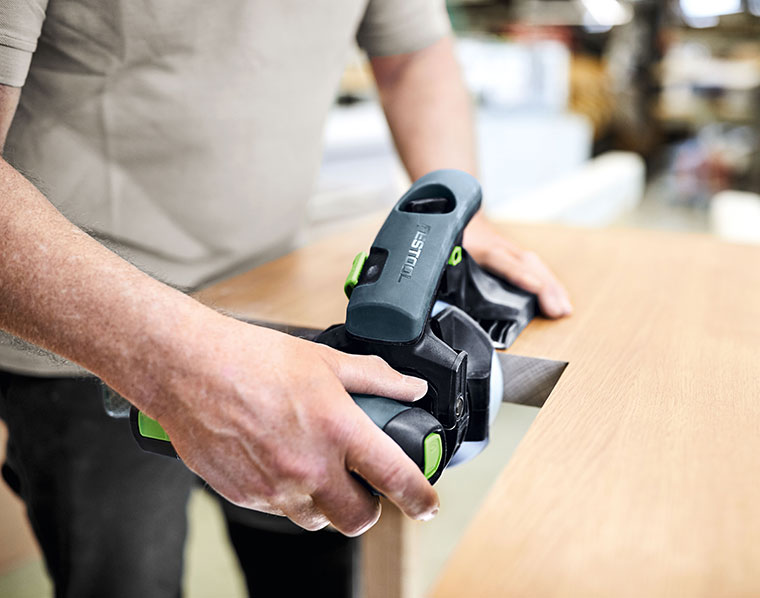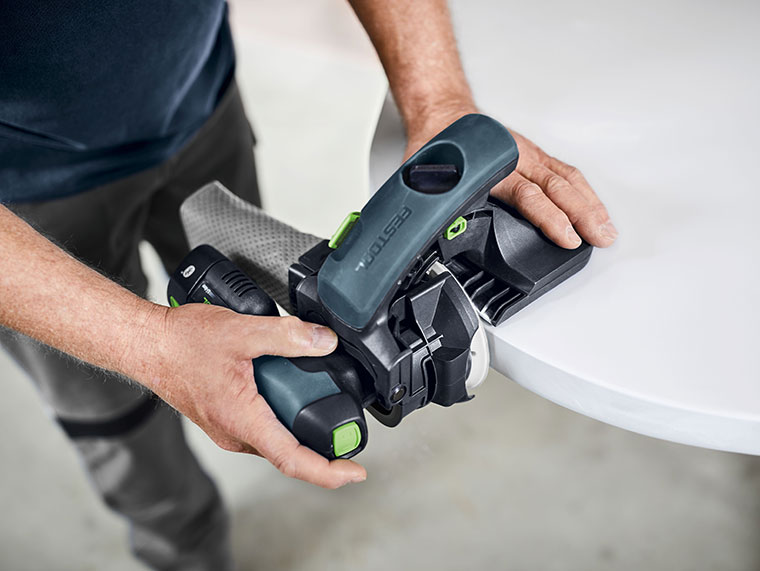Tradespeople are all too familiar with the scenario of laborious, time-consuming sanding using a sanding block, sanding through edges and resurfacing edges. A thankless task and hardly profitable. Every edge is different: Sometimes it is sawn, sometimes it is routed, sometimes it is untreated or painted. To sand edges as easily and effectively as possible, Festool is launching a mobile edge sander in September 2020.
“With our new edge sander, you can finally say goodbye to manual edge sanding. Many people use a hand-sanding block to sand edges and although this is cheap, it is time-consuming, produces a lot of dust and is prone to flaws,” explains product manager Simon Gröger at Festool.
Larger businesses usually have stationary edge belt sanders for coarse sanding applications or machining centres. These can sand edges quickly and cost-effectively. This is good for larger series and batch sizes, but involves considerable investment and operating costs. The stationary systems are less suited to small parts, small series and fine/paint sanding.
“There was previously also the option to sand the edges by hand using an eccentric sander, belt sander or orbital sander. However, this requires skill and expertise, as more aggressive machine sanding can cause the edge to be sanded through or rounded when tipping over. And this usually requires many finishing steps, such as repeated priming or filling,” says Simon.

The new ES-ETS 125/ES-ETSC 125 edge sander from Festool
A mobile edge sander for all edges
The new edge sander is ideal for sanding solid wood as well as for intermediate sanding of paint and filler – for all edge finishing work and for trimming edges with any materials or coating. The new sander makes machine sanding as flexible as manual sanding. However, this process is much faster as the edge sander provides the support of a machine and the results are less prone to flaws.
The edge sander is positioned on the full surface of the edge and ensures perfect sanding of the edge. “We developed the new edge sander so that even from the first application, there is no more tipping over on the edge or sanding through. Compared to edge sanding with a hand-sanding block, time savings of up to 50% can be achieved.
Simply open the new Systainer³, take out the edge sander, position it on the edge and get started – quickly, effectively and faultlessly,” explains Simon. The edge sander makes it possible to sand every type of edge, no matter what it looks like: Whether the edge is straight or curved, untreated or painted, perpendicular or at an angle (from 43° to 92°), whether the workpiece is small, large or bulky, narrow or wide (from 5 to 60mm) – with the new edge sander, all edges can be sanded perfectly. Even external curves on the outline, e.g. on a round dining table, through to inner corners are possible.

Sophisticated detail
The angle adjustment also makes the new edge sander incredibly versatile. This feature enables even free angles to be copied and locked without tools. For the utmost precision, there is a angle display which can be calibrated.
This has the advantage that neither paint nor filler is sanded through. Festool has also come up with a feature to protect the workpiece: It is easy and quick to replace the slideway lining on the cross-headed guide to match the surface – velour linings for delicate surfaces, and plastic lining for all other surfaces. Even painted workpieces can be sanded reliably and conveniently – as well as perfectly and reproducibly.
01284 727270
www.festool.co.uk









